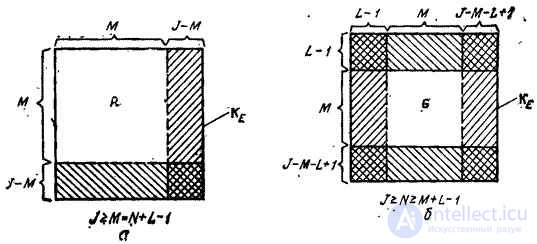Lecture
From the matrix of the cyclic superposition operator  It is possible to obtain the matrices of the superposition operator
It is possible to obtain the matrices of the superposition operator  and discretized superposition operator
and discretized superposition operator  . To do this, enter the selection matrix
. To do this, enter the selection matrix
 , (9.4.1а)
, (9.4.1а)
 , (9.4.1b)
, (9.4.1b)
Where  - unit size matrix
- unit size matrix  . We give the relations connecting these matrices with matrices obtained from them by generalized inversion and transposition:
. We give the relations connecting these matrices with matrices obtained from them by generalized inversion and transposition:
 , (9.4.2а)
, (9.4.2а)
 , (9.4.2b)
, (9.4.2b)
 , (9.4.2в)
, (9.4.2в)
 . (9.4.2g)
. (9.4.2g)
Analyzing the structure of various linear operators, we can show that
 , (9.4.3а)
, (9.4.3а)
 . (9.4.3b)
. (9.4.3b)
So the matrix  formed by highlighting the first
formed by highlighting the first  rows and
rows and  block columns
block columns  matrices
matrices  . At the same time, in all other blocks, the first
. At the same time, in all other blocks, the first  rows and
rows and  columns. Similarly from the matrix
columns. Similarly from the matrix  can form a matrix
can form a matrix  . Matrix elements
. Matrix elements  which matrices are formed
which matrices are formed  and
and  in fig. 9.3.1, and enclosed in frames.
in fig. 9.3.1, and enclosed in frames.
From the definition (9.3.1) of the extended array of samples of the original image, it follows that the vector of samples of the final source image  formed from the vector of the extended image
formed from the vector of the extended image  using the allocation operation:
using the allocation operation:
 , (9.4.4а)
, (9.4.4а)
 . (9.4.4b)
. (9.4.4b)
It can also be shown that the output vector of the superposition operator of finite arrays can be obtained from the output vector of the cyclic superposition operator using the extraction operation:
 . (9.4.5a)
. (9.4.5a)
There is an inverse relationship between vectors.
 . (9.4.5b)
. (9.4.5b)
For a discretized superposition operator
 , (9.4.6)
, (9.4.6)
however the reverse transition from  to
to  cannot be performed due to the underdetermined discretized superposition operator. Transforming
cannot be performed due to the underdetermined discretized superposition operator. Transforming  and
and  in the matrix form, from the relation (9.4.5а) it is possible to obtain the equality
in the matrix form, from the relation (9.4.5а) it is possible to obtain the equality
 . (9.4.7)
. (9.4.7)
Since the selection operator has the property of separability, the formula (9.4.7) is simplified to the form
 . (9.4.8)
. (9.4.8)
Similarly, from equality (9.4.6) relating to the discretized superposition operator, one can obtain the relation
 . (9.4.9)
. (9.4.9)
In fig. 9.4.1 shows the location of the elements of the matrix  the matrices for the superposition operator of finite arrays are formed
the matrices for the superposition operator of finite arrays are formed  and for the discretized superposition operator
and for the discretized superposition operator  .
.

Fig. 9.4.1. Location of the matrices  and
and  in the matrix
in the matrix  .
.
a is a superposition operator of finite arrays; b - discretized superposition operator.
So, for both operators, output vectors can be obtained from the result of cyclic superposition using the operation of extracting a part of the elements. As shown in Ch. 11, this fact allows us to simplify the calculations.
Comments
To leave a comment
Digital image processing
Terms: Digital image processing